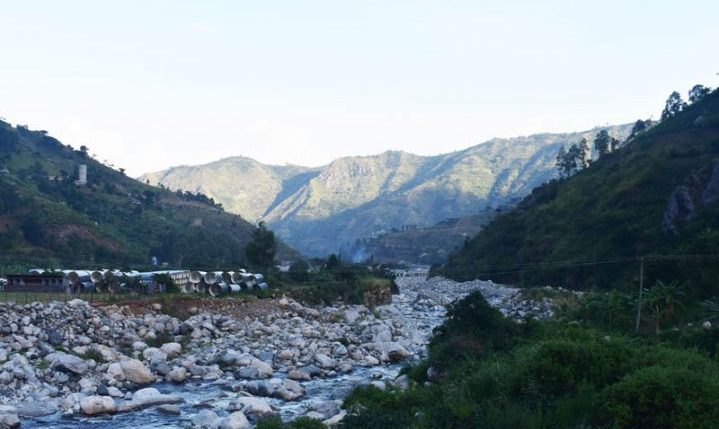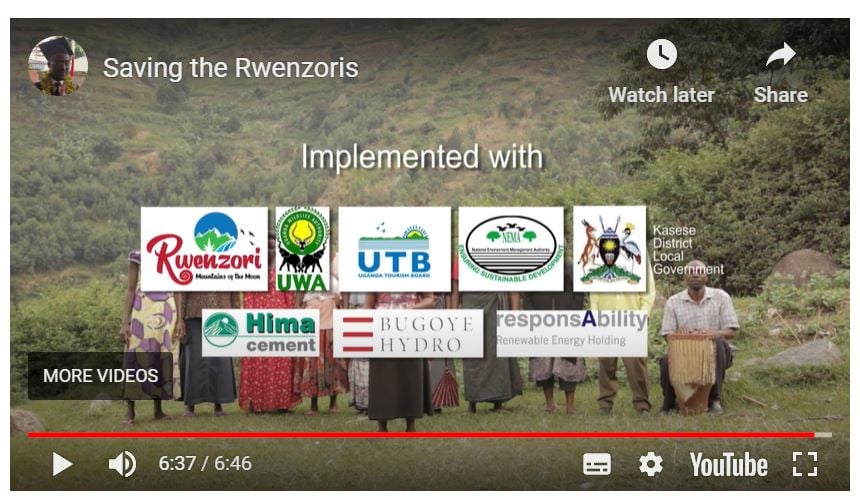
Welcome to week 6 of my #RwenzoriDiary. The series started here …
A few weeks ago, we embarked on a fascinating tour of the Rwenzori region to research the tourism potential of Kasese, Kabarole, Ntoroko and Bundibugyo, the districts surrounding the Rwenzori mountain range. It was an eye-opening trip that has really whet my appetite for exploring the region further.
One morning we drove to the start of the Kilembe Route, one of the main routes to Margherita Peak. This trail is managed by Rwenzori Trekking Services. The last few kilometres of road are difficult and need tarmacing. The views are fabulous!

Our visit to Kilembe, in the foothills of the Rwenzori Mountains near Kasese, showed some of the devastation the area suffered during the flash flood of 2014, in which people, bridges and houses were suddenly – and without warning – washed away.
Four people died but hundreds were injured and many lost their homes. It was not only water that gushed down the steep valley but huge boulders and rocks that wreaked serious damage. Houses were simply swept away in the path of the burst of water. Many community buildings were also damaged or destroyed, meaning that everyone in the area suffered.
Four years after the catastrophic flood, the evidence of destruction is still visible. In this short video clip, we walked over one of the new bridges across the River Nyamambwa.
Thumbnail photo credit Albert Ntambiko.
Kilembe is most famous for being the location of Kilembe Mine, currently closed. However, former mine workers continue to live in this small mining town. It’s a strange place, a mixture of dilapidated colonial-type prefabricated constructions and local houses. The area is littered with boulders, which you quickly come to realise must have thundered down the mountain at deadly speed.
Kilembe, four years after the flood
We were accompanied on our trip by James from World Wildlife Fund Uganda. He explained that the flood had probably occurred due to a combination of factors. In the lead-up to the disaster, there had been two weeks without rain (at a time of year when it normally rains every day). The area of giant Lobelia had dried out and had been burned completely. When the rains finally came, there was no vegetation left to hold the rocks together. Both the absence of rain and the fire can be seen as indicators of global warming. As for what or who started the fire, that is unknown, but natural fires are not uncommon.
You can read the technical explanations about the Kilembe flood here on the New Vision website.
A similar disaster happened in 1966.
Such incidents are thankfully very rare, however, our visit to Kilembe reminded me how vulnerable people who live in the mountains are to climate change. We saw a lot of poverty. There are few jobs and the hilly rocky terrain must be difficult to farm. This in some part explains why people feel they have no option but to enter Rwenzori Mountains National Park and poach bushmeat or cut firewood.
The purpose of our trip was to think how we can support conservation by creating job opportunities for local people. Did you know that tourism employs one in 11 people globally? Whether a porter, working in a lodge, selling vegetables or driving a boda boda, tourism offers money-earning opportunities for a cross-section of people. When they are less reliant on the land – and the protected areas in particular – conservation benefits.


























I have strong memories about Kilembe having been there to work on my first job in the bank as a young impressionable lad. Then in March 1974 the copper mines were in full swing; the town was so vibrant and to many Ugandans and expatriate community it was the place to be. A mix of bad politics and wrong economics however took its toll over the years and Kilembe started crumbling, losing its shine together with other parts of the country. Since the copper and other minerals are still there, Kilembe patiently awaits another renaissance. Thanks to you Charlotte and your team for playing a part in this long arduous journey.
How fascinating Daniel!
We could certainly see how once upon a time this would have been quite a place to live and work. Although mostly dilapidated, the prefab construction was rather interesting with coloured glass windows. We did visit on a rather drab and overcast day. The boulder-strewn countryside and washed-up buildings don’t help the appearance of the place. However, when the clouds part, there are tantalising views of Portal Peaks! That’s what we were therefore after all…
I grew up there too… I was there a month ago (in July) to visit the house we grew up in and see how badly the place was by devastated by the floods. The pictures bring back profound memories… swimming in the river, going to Bulembia School in blue and white uniforms, playing games in the different streets, and inter-street fights. Nostalgia…
Gosh how interesting to read your recollections.
I bet it was cold swimming in that river! I dipped my toes in the river below Ruboni Community Camp – such beautifully clean, clear water – but OMG was it COLD! Straight from the glacier I guess…
I’m proud of the “Rwenzori, Mountains of the Moon” logo that our team developed as part of the rebranding and marketing of the Rwenzori region for the Uganda Tourism Board.

We took inspiration from the colours of the vibrant Rwenzori Turaco.
The Saving the Rwenzoris video was created by WWF (World Wildlife Fund) in Uganda through the “Sustainable Financing of the Rwenzori Mountains National Park” project.
This project identified tourism development as one of the sustainable conservation financing mechanisms that contributes to improved incomes and poverty reduction for the rural populations in the foothills of the Rwenzori.